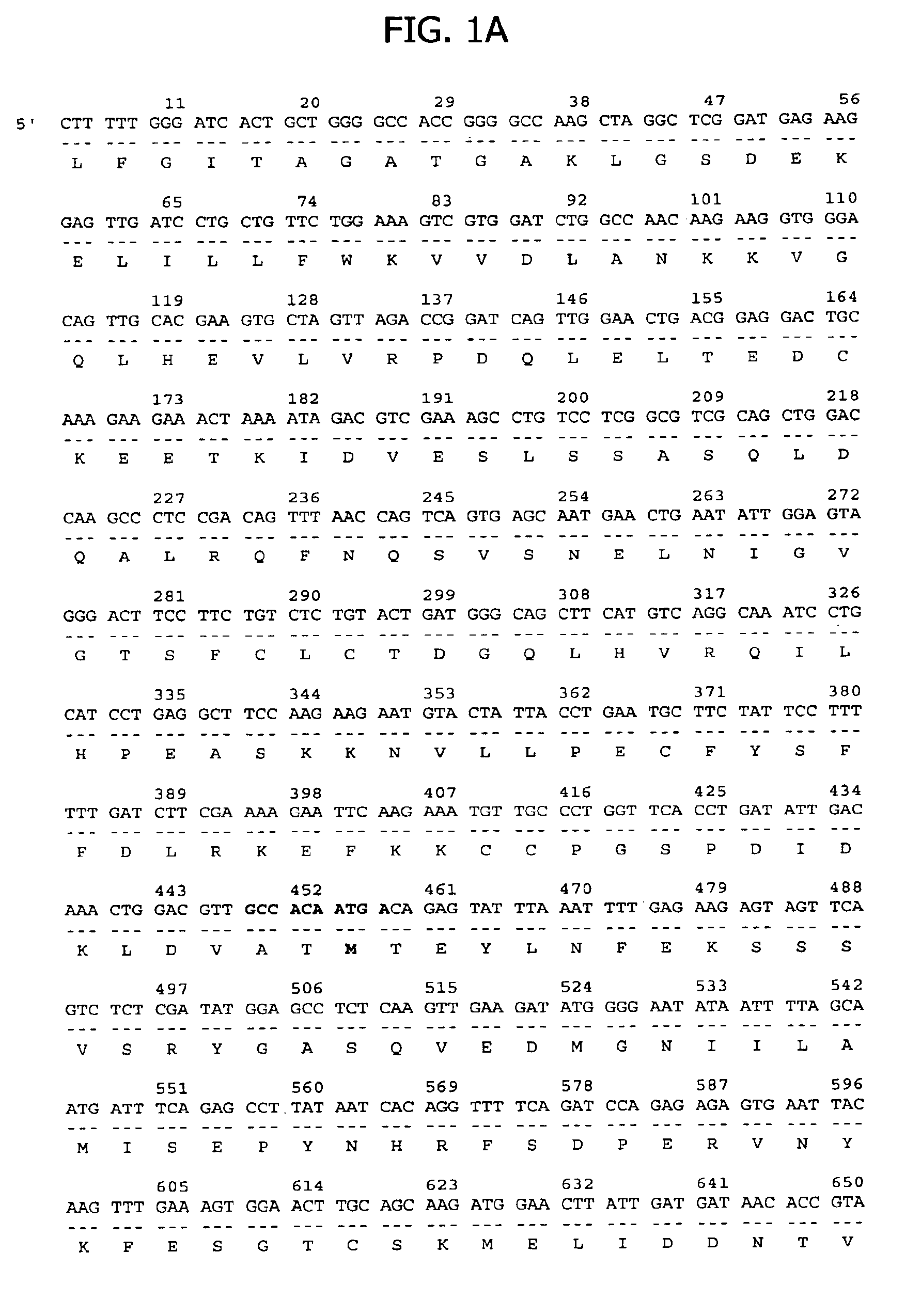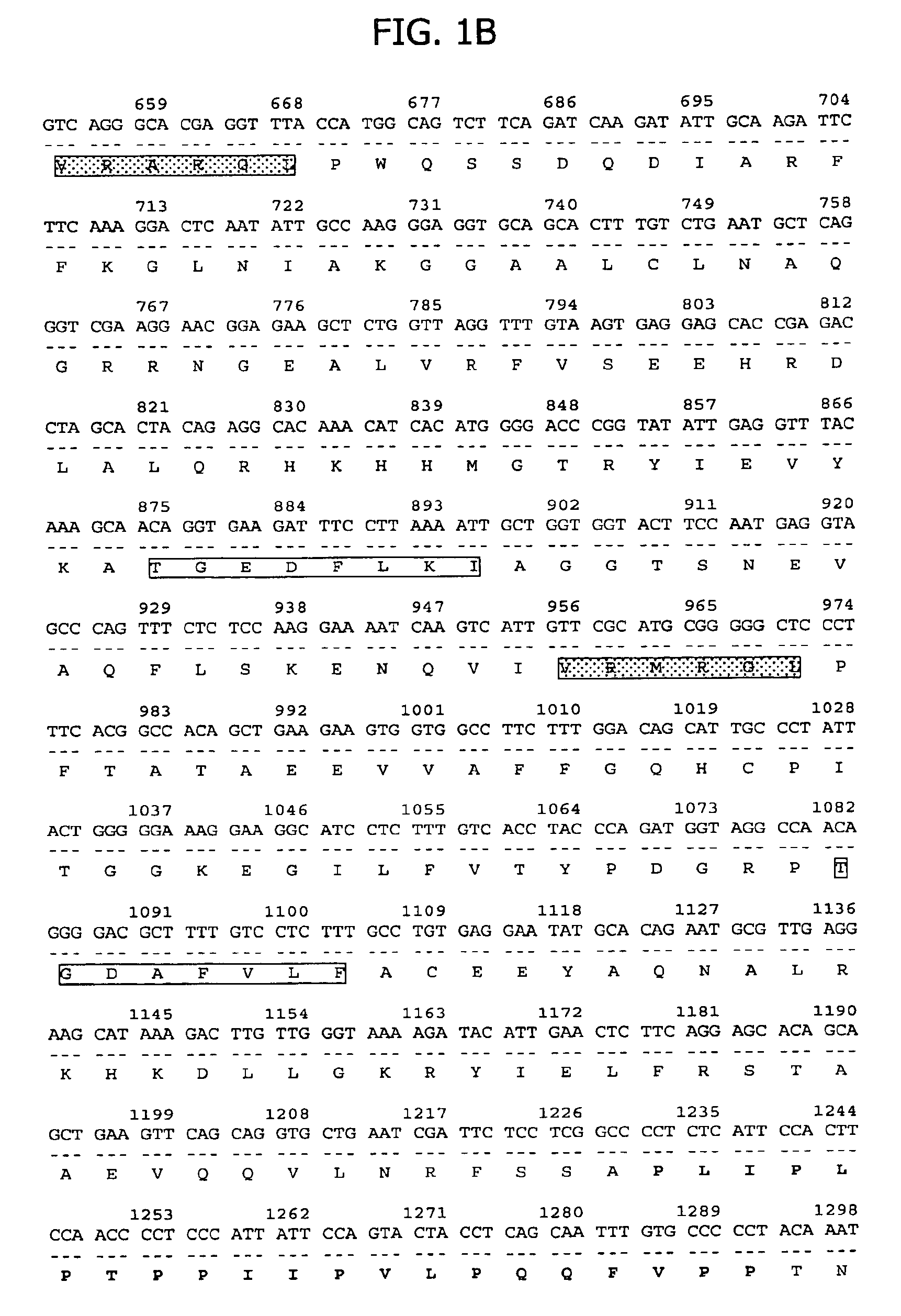Gene upregulated in cancers of the prostate
a prostate cancer and gene upregulation technology, applied in the field of 20p2h8, can solve the problems of low level of 20p2h8, ineffective and non-toxic systemic therapies, and general uneven progress, and achieve the effect of high levels of 20p2h8 expression
- Summary
- Abstract
- Description
- Claims
- Application Information
AI Technical Summary
Benefits of technology
Problems solved by technology
Method used
Image
Examples
example 1
SSH-Generated Isolation of cDNA Fragment of the 20P2H8 Gene Materials and Methods
LAPC Xenografts and Human Tissues:
[0182]LAPC xenografts were obtained from Dr. Charles Sawyers (UCLA) and generated as described (Klein et al, 1997, Nature Med. 3: 402-408). Androgen dependent and independent LAPC-4 xenografts LAPC-4 AD and AI, respectively) and LAPC-9 AD and AI xenografts were grown in male SCID mice and were passaged as small tissue chunks in recipient males. LAPC-4 and -9 AI xenografts were derived from LAPC-4 or -9 AD tumors, respectively. Male mice bearing AD tumors were castrated and maintained for 2-3 months. After the tumors re-grew, the tumors were harvested and passaged in castrated males or in female SCID mice. Human tissues for RNA and protein analyses were obtained from the Human Tissue Resource Center (HTRC) at the UCLA (Los Angeles, Calif.) and from QualTek, Inc. (Santa Barbara, Calif.). A benign prostatic hyperplasia tissue sample was patient-derived.
Cell Lines:
[0183]Hum...
example 2
Isolation of Full Length cDNA Encoding the 20P2H8 gene
[0216]The isolated 20P2H8 gene fragment of 442 bp was used as a probe to identify the full length cDNA for 20P2H8 in a human prostate cDNA library. This resulted in the isolation of a 3600 bp cDNA, clone 20P2H8-GTC2, which encodes a 517 amino acid open reading frame with homology to heterogenous nuclear ribonucleoproteins (hnRNPs). The nucleotide and deduced amino acid sequences encoded by this cDNA are shown in FIG. 1. The highest homology is with a protein identified in C. elegans (CAA92704). Significant homology is also seen with hnRNPs involved in mRNA splicing (ROF, ROH1 and ROH2). 20P2H8 exhibits five RNA binding sequences, two corresponding to ribonucleoprotein-1 (RNP1) consensus sites and three corresponding to RNP2 sites (designated in FIG. 1). In addition, 20P2H8 contains three regions with significant proline content (30-42%), which lie outside regions of homology with hnRNPs (designated in FIG. 1).
example 3
Northern Blot Analysis of 20P2H8 Gene Expression
[0217]20P2H8 mRNA expression in normal human tissues was first analyzed by Northern blotting two multiple tissue blots obtained from Clontech (Palo Alto, Calif.), comprising a total of 16 different normal human tissues, using labeled 20P2H8 cDNA as a probe. RNA samples were quantitatively normalized with a β-actin probe. The results are shown in FIG. 3, Panels A and B, and indicate that, within the 16 tissues tested, the 20P2H8 gene is predominantly expressed as a single 4.4 kb transcript in pancreas, with lower level expression detected in prostate and colon, and lower level expression in placenta (FIG. 3; Panels A and B). No other normal tissues in the panel showed detectable expression.
[0218]In addition, in order to analyze 20P2H8 expression in human cancer tissues and cell lines, RNAs derived from LAPC human prostate cancer xenografts and several cancer cell lines were analyzed by Northern blot using the 20P2H8 cDNA as probe. All R...
PUM
| Property | Measurement | Unit |
|---|---|---|
| temperature | aaaaa | aaaaa |
| pH | aaaaa | aaaaa |
| pH | aaaaa | aaaaa |
Abstract
Description
Claims
Application Information
 Login to View More
Login to View More - R&D
- Intellectual Property
- Life Sciences
- Materials
- Tech Scout
- Unparalleled Data Quality
- Higher Quality Content
- 60% Fewer Hallucinations
Browse by: Latest US Patents, China's latest patents, Technical Efficacy Thesaurus, Application Domain, Technology Topic, Popular Technical Reports.
© 2025 PatSnap. All rights reserved.Legal|Privacy policy|Modern Slavery Act Transparency Statement|Sitemap|About US| Contact US: help@patsnap.com



